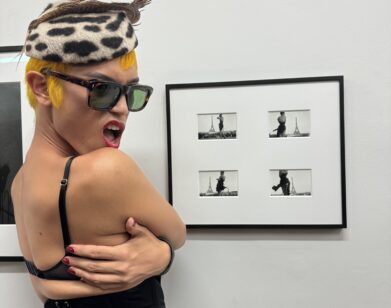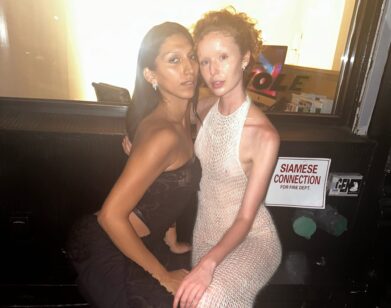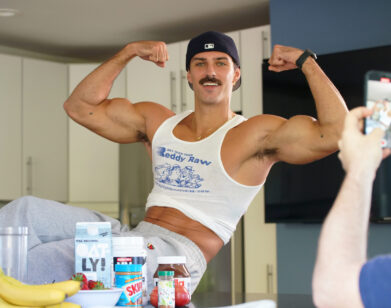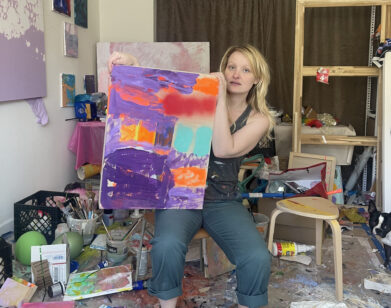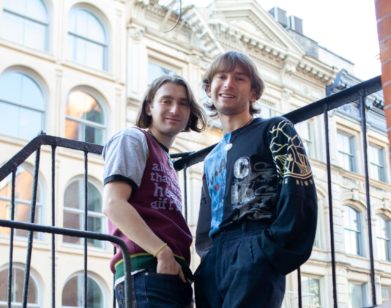IN CONVERSATION
Aria Dean and Louis Osmosis Talk Sculptureand Sperm Banks at Dover Street Market
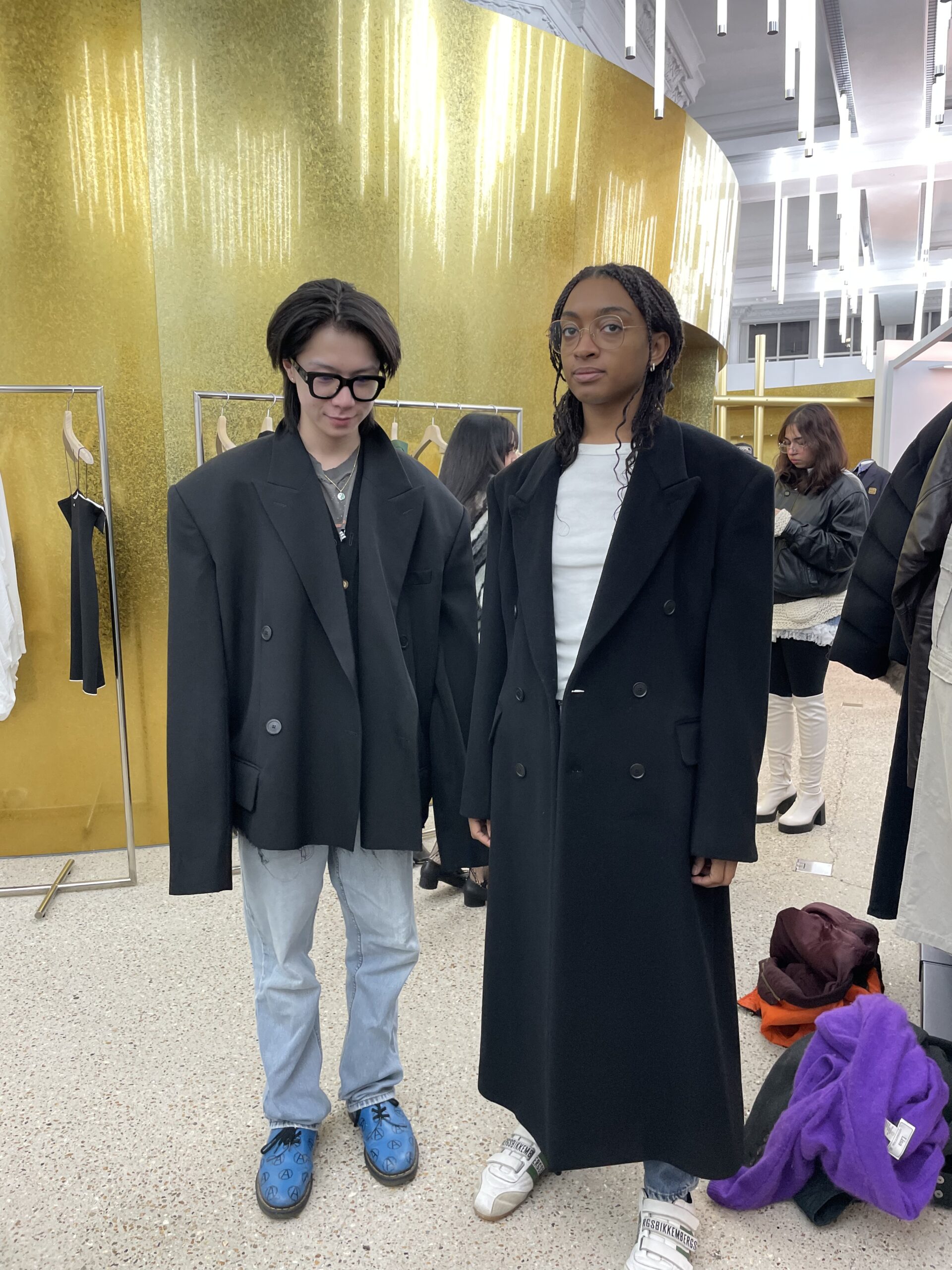
Photo courtesy of Louis Osmosis (left) and Aria Dean (right).
Inside the Institute for Contemporary Art plays “Abattoir, U.S.A.!”, an eery video that tours a simulated abattoir, or the more elegant word for slaughterhouse. Abattoir displays two works by New York artist Aria Dean, who examines the disturbing similarities of slaughterhouses to the systematic violence against Black Americans. Building on the artist’s interest in architectural theory, the show interrogates how the architecture of killing has both generated and sustained modernity. As is the case with much of Dean’s work, the obfuscation of violence is what strikes you. “Not to dunk on other mediums, but it becomes such an intellectually hefty and sensuous activity,” Dean told fellow artist Louis Osmosis when the two got together earlier this month. Here in New York, Osmosis also has a show currently on view: Queues, at the downtown gallery Kapp Kapp. The gallery space, revamped into a formidable TSA line carved out with stanchions, is decorated with pearly white sperm sculptures standing at attention and a print of the Statue of Liberty with a Getty images watermark. After a visit to Dover Street Market in London, the two artists talked about gamifying exhibition openings and the Italian airport that led to Osmosis to probe a generative question: “How do you make a wallier wall?”
———
LOUIS OSMOSIS: What’s up, bro? This is a funny little Tuesday activity.
DEAN: Yeah, I feel like my brain is pretty wrung out.
OSMOSIS: I’m not good. I’m not good.
DEAN: Yeah. I feel kind of okay. I feel like, after this, I’m going to power down or something. How does this show sit in relation to other shows you’ve made? How do you see exhibition-making in succession? Because also you’ve done a number of shows in the last few years in the city.
OSMOSIS: Yeah. I said this to you at the opening, that this show was the first time I realized I didn’t have to participate in the triumph narrative or the emotional spectacle. I felt very clear-eyed instead of doe-eyed, which was fantastic. At the opening I had this Minority Report kind of filter in my head where I was like, “Ah, okay, that’s not working, that’s working. I see how this person’s interacting with that piece. Oh, that’s a funny thing I should riff on,” which has been really difficult to do with the other openings.
DEAN: Why do you think you felt more clear-eyed? Do you think it is getting practice, or reaching a point where you’re like, “Oh, I’ve done a few shows.” Or do you think there’s something in particular about your disposition towards the work or the process of making it?
OSMOSIS: Maybe more so the latter, but the former is a more ambient thing. One reason why I asked for a January slot was to make it so that going outside for respite from an opening isn’t the first instinct for someone, because I wanted to get into the sardine thing of queues. The real impetus for the show was to take my own trajectory and try to gamify, using myself as a model within this larger Petri dish of exhibition-making. In my head, I kept being like, “Oh, third time’s a charm,” you know what I’m saying? But then I guess the Pope.L thing here, him being my guy, I was like, “Oh, I should take that literally. What is the charm here to the third time?” And then have it kind of maybe implode on itself with all the poetics or something like that. Because from someone like a Pope.L and a Lutz Bacher, there was a really economical means of generating poetics that I think also within it can house a Joe Schmoe’s experience with the work, but also some kunst person of just taking things for their literalness. Because then I think poetics come out of an avalanching of that interior logic. And so I was like, “The best way to do that is if I just really try and implicate myself without making it biographical,” I guess.
DEAN: I see that. When I walked in there, and also having been in your studio, it feels like you, but also a critique of your own work. Not a critique that is biographical, but critiquing your position. When you say you’re using yourself as a specimen, what parts of you are on display or are being worked through?
OSMOSIS: I tend to think of these sculptural objects as aspirational proxies that are at one point involved in affirming a sort of artistic or cultural production. They are also complicit in the lack that’s inherent within that, you know what I’m saying? The most preliminary form of the aspirational proxy would just be the artist proper. That is where the “provability” comes in. That’s a term I think about all the time, an object whose moment of inception comes from a prompt or a thought experiment or a, “I don’t know what’s going to happen next” kind of question. It’s like you’re making a horcrux to contend with at every moment. Now, is that a strategy that might change down the line? I don’t know. But for this show, it did a lot for me in thinking about a constellation of problems to work with.
DEAN: With the sperms, and I think with your work overall, it’s like you have this interest and maybe even a love of art history. It’s like, “Okay, we’re all kind of at this stage in art history, stuck in trying to position ourselves in relation to and against these bigger sperms that we have followed in the footsteps of or idolized, but then differentiating ourselves? And I’m this one, I’m that one, whatever.” Having these characters present with something like that room that has this sort of architectural intervention thing going on, and then also the queues, which is funny.
OSMOSIS: Yeah.

Louis Osmosis, Big Mascot (Ragamuffin), 2024. Reinforced paper-mache, various foams, steel, polyurethane, spray paint, adhesive. 82 x 26 x 24 inches. Images courtesy of Kapp Kapp.
DEAN: Yeah, this deconstructed theatrical situation. In this show with the stanchions, the viewer does get really involved. I’ve noticed you’ve done little things in terms of trying to usher people in certain ways or draw them into certain things. This time it felt very full-fledged. I was curious about specific works, like the wall with the Statue of Liberty and the sculptures. Can you talk about that?
OSMOSIS: Yeah. When I went to Italy last summer, it was my first time in a mini airport. It was a very middle-of-nowhere vibe. It was funny to see this lag in bureaucracy. It felt as if 9/11 hadn’t happened yet. They had these facsimiles of objects that were crafted at every turning point. They made a point of hyper-realism to essentially signify contraband. Specifically, an ivory tusk that was clearly made of plastic, or a Supreme Louis Vuitton bag that was a bootleg, or an elephant foot that was a fiberglass cast of an elephant foot. I was like, “This is so cool.” Not only have they doubled down on this linear choreography via these stanchions, but they’ve also created a moment where your gaze would go perpendicular to how you’re walking. They adhere it to the wall by making objects that are supposed to negate themselves. They are not supposed to exist, yet this prop facsimile of them does. It creates this mini model of how bureaucracy and neoliberalism functions. I was like, “If they’re going to turn every corner into a viewing booth, then I should engage this really picturesque wall in the same fashion.” So the prompt I gave myself was, “How do you make a wallier wall?” I was like, let’s have the wallpaper prioritize its dimensions and not the fidelity of the image. Then let’s use a free image of freedom, hence the Getty Images thing.
DEAN: I really love that wall. Also thinking about materials and services, without a building, that floating wood of a poorly boarded up window becomes just wood again. It’s not made out of wood, right? Are they Papier-mâché?
OSMOSIS: Yes.
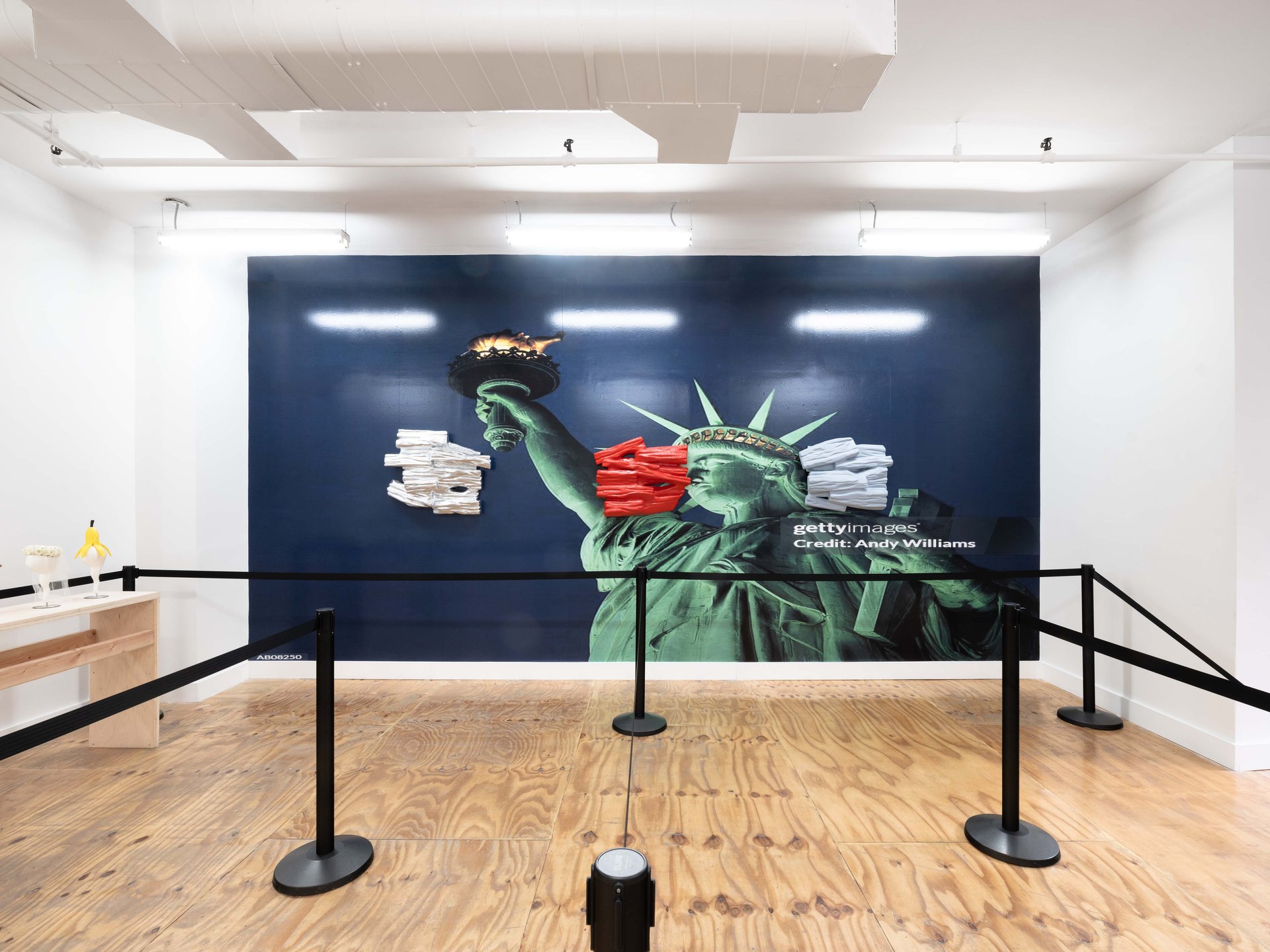
Installation view of Queues.
DEAN: It’s really well-made, which calls attention to the labor. You have 3D prints also in this show, so by having both of those alongside each other, it’s these different processes that can eventuate in highly detailed object making. It doesn’t seem to me that you’re interested in how easy it is to duplicate something. You’re more interested in what it does in that space or context.
OSMOSIS: That’s a really great way to phrase it. My homegirl, Olivia [Rodrigues], who wrote the press release, hit the nail on the head using the term “hyper-artisanal good,” this object that’s in between being hyper-scarce and hyper-manufactured. This is that mode that’s way more akin to when you get off a cruise ship on some random island and there’s a table full of these little turtle trinkets that are all made by the local community, you know what I’m saying? Like a mini-factory.
DEAN: With microeconomies, it’s like small batch artisanal produced, the very millennial, middle-class aesthetic of, “I make candles that are very specific to me, but they’re not so specific that they’s one of a kind each of them, or they’re not aspiring to be world craftsmanship.” Yeah, the mini-factory is probably the method that most artist studios exist within at scale. But also, in contemporary culture, in a world where the middle class doesn’t really exist, it’s more, “I have a little factory in my house.”
OSMOSIS: Yeah, exactly. A funny way to think about it would be if you were to babify Fritz Lang’s workers leaving the factory and instead it’s the same footage and perspective of a lowly artist leaving their shared studio space. We’re circling around what I would call this, “live, laugh, love,” microeconomy of object-making that goes into that model of iteration. You “iterate, iterate, iterate,” as Olivia so aptly put. It sets up this paradigm like, “How much do you iterate before you rebrand?” The economy of the rebrand is a positionality in and of itself.
DEAN: I’m thinking about what it means to make things in culture where things seem to be endlessly iterative. Now, a lot more of the culture industry relies on engineered scarcity. I think about this with sculpture, making digital works that could in theory be infinitely reproduced but can’t be because of market principles. But also I’m like, “How many sculptures that look similar should I be making before that’s a bad idea?”
OSMOSIS: To that point, there’s a Lauren Berlant quote that is applicable here, something along the lines of, “The resistance found at the moment of production since it figures the moment of consumption as an act of reuse,” which is a really great way to think about that. It’s not like I’m trying to unpack what it means to make the multiple of the thing. It’s more, “Where is square one of production?” It’s like the chicken and egg thing. Production precedes consumption, but then that proceeds production, and so on. That also posits this means of object making that starts to have its vernacular be scrambled and become incestuous. It makes for these inbred objects that can involve themselves in a dramaturgy of themselves.
DEAN: This brings us to something that I think about often. With the status of sculpture right now, there is this incestuous thing where sculpture can only ever refer back to itself. Because we’ve passed through the ready-made and nineties installation art, it means that sculpture refers back to objects. Also, as you’re saying, there’s multiple objects circumscribed by, “We’re viewing it in the private showroom or in the gallery.” Not to dunk on other mediums, but it becomes such an intellectually hefty and sensuous activity. Then also it comes up against this problem where it’s a narcissistic, incestuous project that has a lot of importance and impact outside of itself. When you’re making a show, it’s hard to figure out why something is there. It’s just there because it’s there.
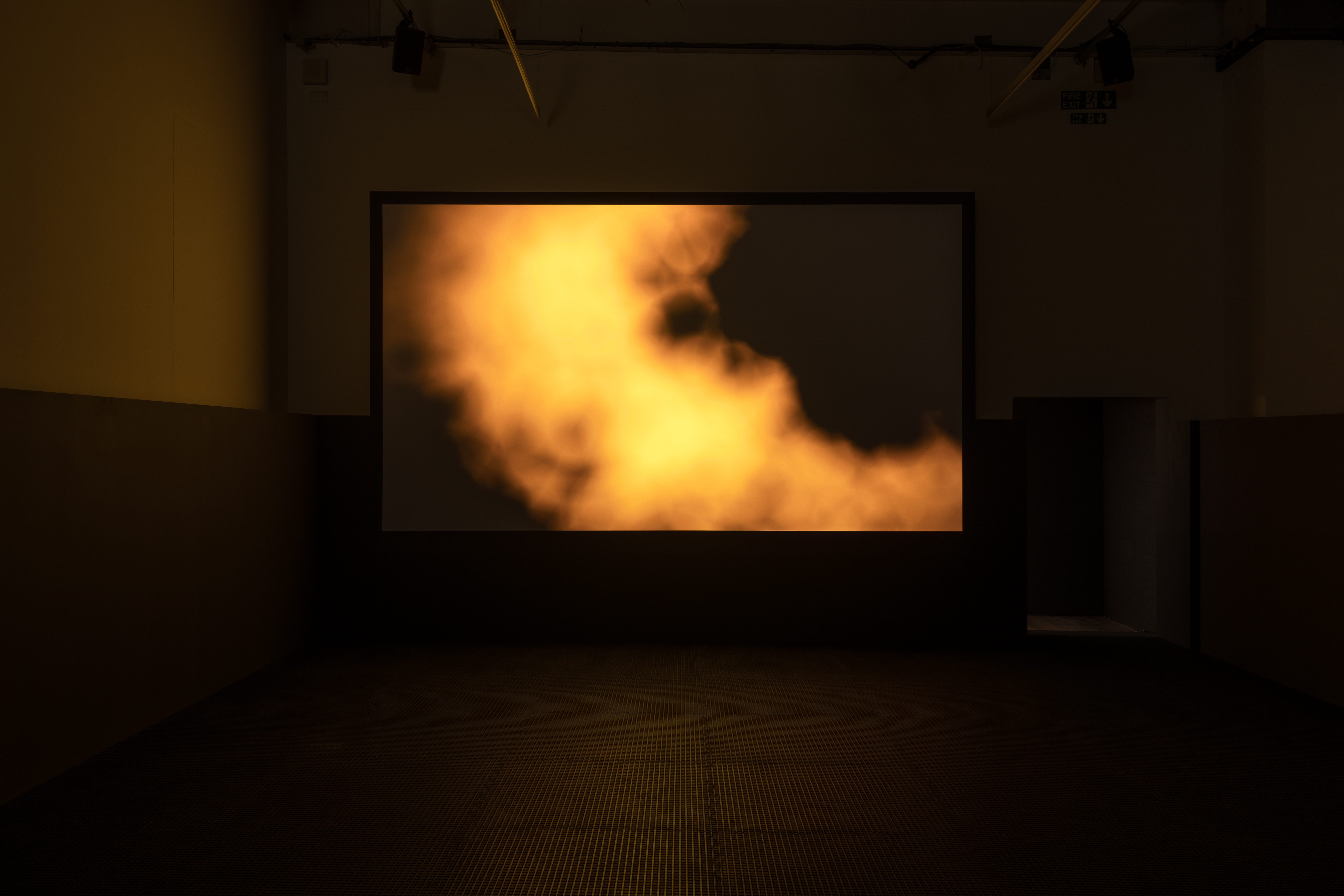
Aria Dean, Abattoir, U.S.A.!, 2023, single-channel video, sound, colour, 10 min. 50 sec. Installation view: Aria Dean: Abattoir, Institute of Contemporary Arts, London, 2024. Courtesy the artist, Greene Naftali, New York and Château Shatto, Los Angeles. Photo: Rob Harris, ICA.
OSMOSIS: Mm-hmm.
DEAN: It’s almost too much freedom. When you were talking about consumption and production, it reminded me of our conversations about fashion. Especially in London, when we we’re at Dover Street Market we’re both like, “I don’t want this stuff.” Dover Street Market just affirms us wanting to just go on Grailed and eBay and buy the stuff.
OSMOSIS: Yeah, that serves as a cool allegory for how the art object functions now, post ready-made, post-Warhol. It inherently and latently gamifies its origin source as it ties back to the maker, but also where it lands for globalization. The full-fledged marketry of the object where it muddies its own causality of how and wherever the fuck it landed, because it’s like enraptured in its glitter. The hypebeast is a great model to talk about that. It’s low connoisseurship, which is the baby version of the proper art connoisseur. It’s like this steeple of microeconomics. It’s not a trickle down, but more a widening of the thing. I wonder how much that base can widen before it just flattens itself. Not to be a doomer, accelerationist guy…
DEAN: Right. I remember years ago, when the “drop” model of hypebeast sneakers started to bleed into high fashion. It makes me think about engineered scarcity. It’s like, everyone could have whatever new Nike shoe, but we engineer the scarcity to create a market, and that’s the case for almost everything. My cousin sent me a video on Instagram of some sculpture in someone’s house that looked almost identical to the cube collision sculptures that I made. I was like, “I don’t mind.” I don’t even know if that was a rip-off, but value is so interesting here, because I don’t know where this came from or what it’s technically worth, but I know how much my sculptures are technically worth and that probably isn’t the same amount. I was watching that movie about the GameStop short on a plane, and I was like, “Yeah, money isn’t real.” Value is real but it’s not fixed. It touches every part of life. Even with clothing, going to Dover Street Market or walking down the street and you see people, maybe someone’s wearing the same thing you have, but they’re wearing it a different way. I’ve seen girls in a certain kind of cut of leather jacket that I had at home for years from college. And then being like, “If I wear that, do I look like a 16-year-old who shops at Brandy Melville?”
OSMOSIS: Right. When we were in London, I was seeing all these Brits who were on this very cobweb-laden mode of being hypebeasts that were left behind. They’re still doing skinny jeans, Balmain biker jeans with Jordans, and then a tight shirt and a cross-body bag. Here, it’s all, tiny shirt, big pants moment. It made me think of art history being adjacent to a present mode of production. Also, how fashion is this kind of conduit for taste-making or the trend economy. Not to go full circle here, but everything lives within a sperm bank and we are all just illegitimate children of one another within this muddied causality that we find ourselves in.
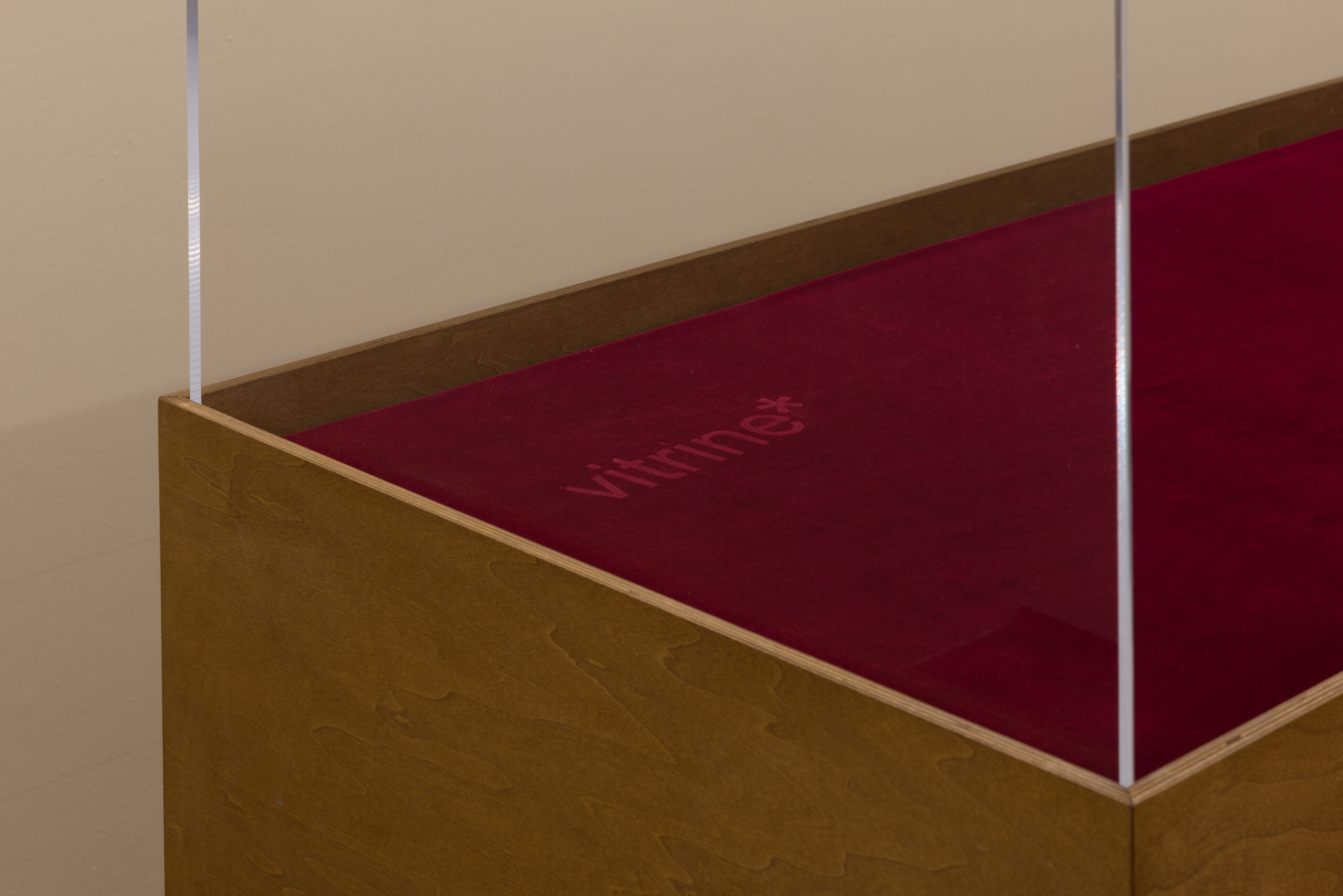
Aria Dean, Vitrine*, 2024, four vitrines with branded text on velvet, wadding, hardboard, plywood, acrylic, and vinyl text on wall. Installation view, Aria Dean: Abattoir, Institute of Contemporary Arts, London, 2024. Courtesy the artist and ICA. Photo: Rob Harris, ICA.

